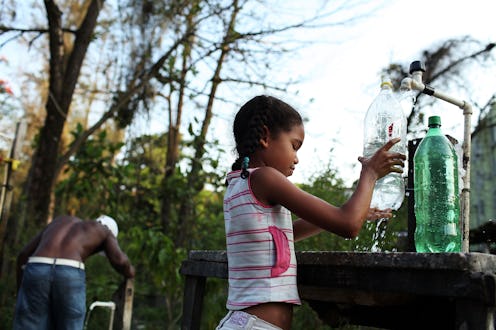Life
How To Instantly Find Out What's Actually In Your Tap Water

In the last decade, there has been a number of revelations about the quality of water in towns across America. For that reason, you might have wondered if your own drinking water is safe, though it can be hard to know where you can even find that information to begin with. Luckily, a newly updated tool is available for you, and helps you find out exactly which contaminants you could be ingesting every day by drinking tap water.
On Oct. 23, the Environmental Working Group (EWG) released an updated national drinking water database that lets you to plug in your zip code and find out what contaminants exist, if any, in your local drinking water. The organization, a nonprofit activist group that is "dedicated to protecting human health and the environment," per its site, compiled the database by collecting annual data from approximately 50,000 local utilities across every state.
As the organization notes, the EPA has not added any contaminants to its list of regulated pollutants under the Safe Drinking Water Act since 1996. What's more, many of the "safe levels" of these contaminants, as determined by the EPA, aren't actually considered safe by the EWG. The organization is quick to clarify that "legal" does not always mean "safe" — that's why its suggested guidelines are stricter than what you'd find on the EPA's site.
Dr. Tasha Stoiber, Ph.D., a senior scientist at the EWG, explains that the database is part of an effort to increase transparency and let people know how safe their drinking water really is. "The legal limits for contaminants are sometimes compromises based on cost of treatment, or from decades-old analytic methods [that are] quite outdated," she says to Bustle. "So what we’ve done in this database is say, 'Hey, with the most up to date science, what would our standards be for drinking water?'"
Luckily, this database provides you with all the information you need. Once you type in your zip code, you will be greeted with a page that shows you how many contaminants in total were found in your local drinking water, and whether any of those contaminants exceed the EWG's health guidelines.
You can also learn more about each of the contaminants found in your local drinking water, what they mean, and what concentration was found. What you will likely find is that many of the contaminants found in your water aren't even legally regulated. And in a lot of cases, more research might be required to figure out whether they can impact people's health overtime.
If you're feeling freaked out by the idea of contaminants in your water, there are definitely solutions available — and they do not include buying tons and tons of plastic water bottles.
"Bottled water is not the answer," Stoiber explains. "We don't want people to start buying bottle water [for their daily lives]." In fact, bottled water isn't even necessarily safer, she argues, because companies aren't required to disclose contaminants in their bottled water.
Instead, Stoiber suggests that you use an in-home filter to filter your tap water. She adds, "It’s a lot cheaper and better for your health." The EWG offers a guide to water filters available for purchase, depending on what contaminant you want to filter out and how much money you want to spend.
The database also gives you some options for taking action, if you want to do so. "If you are concerned about your drinking water quality, or if you think your community deserves better, reach out to your local representatives," Stoiber says. Information on how to do that can be found here; you'll also find examples of questions to ask your elected officials about water quality levels and regulations, if you're looking for inspiration.
Experts:
Dr. Tasha Stoiber, Ph.D., senior scientist at Environmental Working Group
This article was originally published on